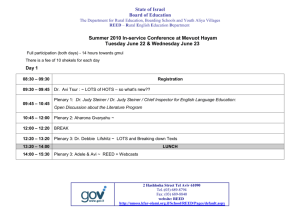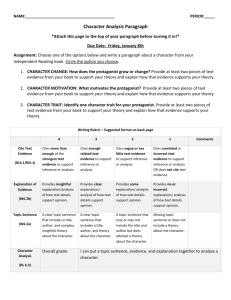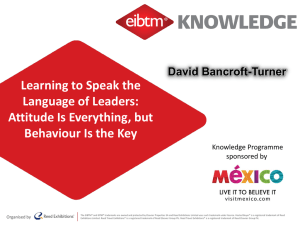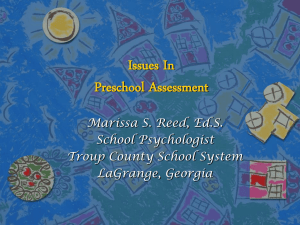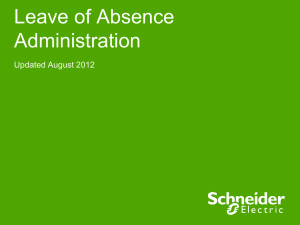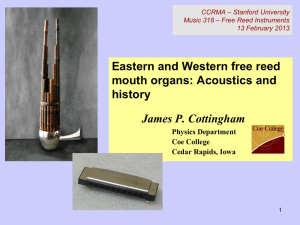90/90/90: High Performance In High Poverty Schools
advertisement
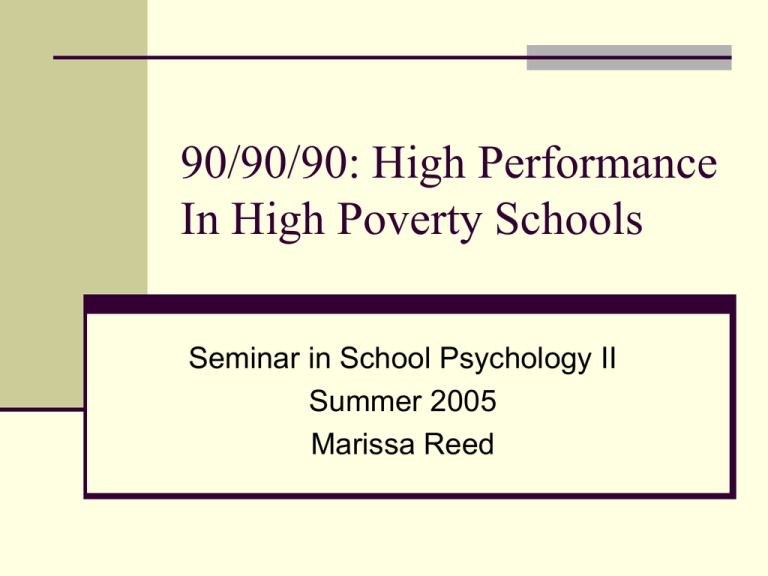
90/90/90: High Performance In High Poverty Schools Seminar in School Psychology II Summer 2005 Marissa Reed Bulk of research and information Reeves book, Chapter 19 Center for Performance Assessment Four years of test data (1995-1998) Elementary through high school 228 buildings, more than 130,000 students Rural, suburban, and urban schools Populations were mostly poor and/or minority to largely Anglo and/or economically disadvantaged Authors are not supporting a particular program Reed, 2005 Common assumptions… Reed, 2005 90/90/90 Schools: What are they? Over 90% poverty Eligibility for free and reduced lunch as surrogate for low-income families Over 90% minority Ethnic minorities Over 90% achieving at high proficiency levels Independently conducted tests of academic achievement Reed, 2005 Common characteristics of 90/90/90 schools 1. Focus on academic achievement 2. Clear curriculum choices 3. Frequent assessment of student progress and multiple opportunities for improvement 4. Written responses in performance assessments 5. Collaborative scoring of student work Reed, 2005 1. Focus on academic achievement Data everywhere in schools: charts, graphs, and tables on student achievement and continuous improvement School trophy cases displayed exemplary academic work, including essays, projects, and papers Shows that academic performance is highly prized Emphasis on improvement Comprehensive accountability system: each school was forced to identify five areas in which they measured improvement Reed, 2005 2. Curriculum choices More time spent on the core subjects of reading, writing, and math and less time on other subjects Emphasis on these core skills in order to improve student opportunities for success in other academic endeavors later Schools outperformed their peer schools on science tests as well Authors concluded that this showed that tests in other subjects are tests of reading and writing Reed, 2005 3. Frequent assessment of student progress with multiple opportunities for improvement Student performance that was less than proficient followed by multiple opportunities to improve performance Versus penalty for poor performance=low grade and forced march to the next unit Versus no additional opportunities to succeed if student does not “get it right the first time” Most schools conducted weekly assessments of student progress Teacher constructed and administered, not district or state tests Reed, 2005 4. Written responses in performance assessments Schools required written responses in their performance assessments Versus oral student responses Appears to help teachers obtain better diagnostic information about students, and helps students demonstrate the thinking process they employed to find their response to an academic challenge Allows teachers to create the strategies necessary to improve performance for both teacher and learner Reed, 2005 4. Written responses in performance assessments (continued) High emphasis on informative writing Single scoring rubric used to evaluate every piece of written work Book reports, lab reports, social studies reports, analysis of sporting event, etc. Message: this is the standard for good writing, and there are no compromises on these expectations for quality Benefits: Students process information in a much clearer way when they are required to write an answer; “write and think” and clarify their own thought processes Teachers gain rich and complex diagnostic information about whey students are responding they way they are Vs. binary feedback (right or wrong) Reed, 2005 Vocabulary issues? Misunderstood directions? Reasoning errors? etc. 5. Collaborative scoring of student work So that “no accident of geography or classroom assignment would determine expectations for students” Common assessment practices developed, along with regular exchanges of student papers Teachers and teachers Principals and other schools Principals evaluating student work also Target inter-rater reliability=.80 Causes of disagreement: Implicit scoring criteria which are not a part of the official scoring guide Reed, 2005 Lack of clear specifications in the scoring guide itself Other characteristics… Success without proprietary programs Use of similar techniques without externally imposed methods of instruction Accountability report findings: Techniques are persistent Techniques are replicable Techniques are consistent (writing, performance assessment, collaboration, and focus on learning Keys to improved achievement=professional practices of teachers and leaders, not the economic, ethnic, or linguistic characteristics of the students Reed, 2005 Nine characteristics that distinguished schools with the greatest academic gains 1. collaboration 2. feedback 3. schedule changes 4. action research and mid-course corrections 5. aligning teacher assignments with teacher preparation 6. constructive data analysis 7. common assessments 8. value of every adult in the system 9. cross-disciplinary integration Reed, 2005 1. Collaboration Examination of student work Talking about what “proficiency” really means “very frequently and in some cases…every day” Intentional focus on scoring student work Transmit other information usually talked about in meetings in writing Professional development time devoted to collaborative scoring Reed, 2005 2. Feedback Significantly more feedback provided to students than the typical report card Mirror music and physical education teachers’ practices Precise and immediate Triage approach Traditional report cards provided to successful and self-directed students, with weekly reports for students who were struggling Reed, 2005 3. Schedule changes Elementary level: 3 hours a day devoted to literacy (2 for reading and 1 for writing) Secondary level: Double periods of English and mathematics Reed, 2005 4. Action research and mid-course corrections School accountability plans dynamic and flexible Change of goals and strategies that were not effective and start new ones that held promise, even during the school year Share what works with other teachers Word wall example Reed, 2005 5. Aligning teacher assignments with teacher preparation Reassign teachers to different grades within the same school if their preparation is better suited to a different grade level Idea that teachers whose undergraduate backgrounds fail to match the standards are not bad people nor are they unprofessional educators Find a job that best meets the teacher’s abilities and backgrounds, not seek to “fix” the person Reed, 2005 6. Constructive data analysis An intensive focus on student data from multiple sources, and specifically focused on cohort data Compare the same student to the same student Compare students to themselves rather than to other groups of students Focus teacher strategies on the needs of their students and not on generic improvement methods Reed, 2005 7. Common assessments Testing versus assessment Testing=end-of-year, summative, evaluative process Assessment=have student complete a task and then very soon they receive feedback that is designed to improve their performance Use assessment data to make real-time decisions and restructure their teaching accordingly Allows for a combination of daily discretion and independence by teachers, while preserving a school-wide commitment to equity and consistency of expectations Reed, 2005 8. Value of every adult in the system Profound respect for every employee, including bus drivers and cafeteria workers Inclusion of all employees in professional development opportunities in classroom management and student behavior Every adult leader is regarded as a significant adult leader in the eyes of students Schools that employed this profound respect witnessed dramatic improvements in student behavior Reed, 2005 9. Cross-disciplinary integration The involvement of seemingly peripheral subjects in academic achievement Example: Students need to work on fractions, ratios, and measurement in mathematics, so music teacher develops activities in which musical rhythms reveal the relationship of whole-notes, half-notes and quarter notes; art teachers work on perspective and other representational art that makes explicit use of scale; gym teachers allow students to choose to run either a millimeter or a kilometer Reed, 2005 Reeves’ defense against critics Need a balance of state, district, and school-based assessment measures Excessive time devoted to reading is better so that students can enter secondary school able to read at grade level A parallel comparison was made to high poverty, high minority schools for students with good attendance and continuous enrollment, but who did not have the success of students in the 90/90/90 Schools An expensive program (such as Success For All) was not used consistently in the 90/90/90 Schools; the professional practices employed by teachers and leaders in the building was the predictor of success Effects sustainable, with some schools maintaining effects through different principals and high faculty turnover Marzano, 2003 Meta-analysis that indicates the importance of teaching, curriculum, and leadership relative to poverty and ethnic identity Reed, 2005 Urban success stories Reeves: Norfolk Public Schools, Virginia Wayne Township Metropolitan School Corporation, Indianapolis, Indiana Riverview Gardens and Hazelwood School Districts, St. Louis, Missouri Los Angeles County and Orange County, California school systems in urban, suburban, and rural school systems http://www.inmotionmagazine.com/er/hphm_a nderson.html#Anchor-In-49575 Reed, 2005 Application to Ellis Chapter 3 Level II Would need large-scale program evaluation to have Level III research Reeves and others are going backwards… they are looking at schools who have achieved success and seeing what worked for them…now someone needs to apply what has worked for them to schools that need to achieve success using good research techniques, and see if these theories hold up Agree? Reed, 2005 References Anderson, T. (n.d.) High performing high minority elementary schools: Where are they located and what do they have in common? Retrieved August 8, 2005 from http://www.inmotionmagazine.com/er/ hphm_anderson.html#Anchor-In-49575 Marzano, R.J. (2003) What works in schools: Translating research into action. Alexandria, VA: ASCD. Reeves, D.B. (2000). The 90/90/90 Schools: A case study. In Accountability in action: A blueprint for learning organizations, 2nd ed. (pp. 185-208). Denver, CO: Advanced Learning Press. Reed, 2005
